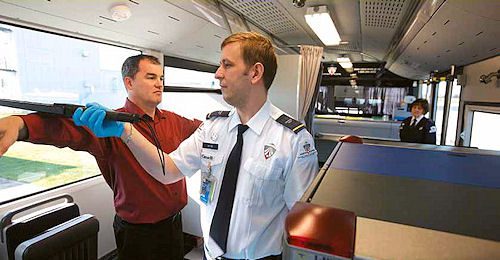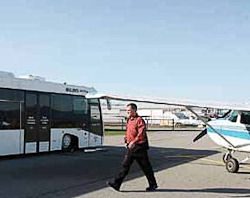 |
|
Facts & Figures Project: Mobile Screening Operations Owner/Operator: Canadian Air Transport Security Authority Vehicle: Scan 3000 Manufacturer: CONTRAC COBUS Industries Cost: $800,000 – $1 million, depending on customer-selected options Olympic Deployment: Airport venues without screening facilities in terminal buildings, such as FBOs, float plane operations and helicopter facilities On-Board Equipment: Metal detectors by CEIA, Explosives Trace Detection and X-ray machines by Smiths Detection Primary Benefits: Flexibility and mobility to screen passengers at non-traditional locations |
A special team of 150 screeners from around Canada was assembled to operate the mobile units. Screeners were selected through a merit-based process and assigned to different locations around British Columbia and Calgary during the Olympic Games. Each vehicle was staffed with five screening officers, just like a standard airport screening line, Larocque notes. Because the screening equipment in the mobile vehicles is the same as in airports, no additional training was required other than an orientation about how to operate the vehicle itself.
During the Olympics, the mobile screening vehicles proved “perfect” for assignments at locations that lacked terminal buildings, reports Larocque. In the future, they’re expected to be used during other major international events like G8 and G20 meetings. And if Transport Canada requires CATSA to provide ongoing screening at FBOs, Larocque anticipates the buses could be used for that purpose, too.
The main benefits the vehicles provided to CATSA during the Olympics were flexibility and mobility to perform screening whenever and wherever necessary. Some of the mobile units, for instance, stayed at Vancouver International Airport FBOs so screeners were ready to handle passenger traffic at all times. Elsewhere at the airport, however, CATSA did not always know when VIP passenger screening would be needed. “We could receive a call in the middle of the night saying, ‘X country’s delegation is going to be landing tomorrow morning,'” Larocque explains. “In that case, we could just gather screening officers, put them on the bus, drive it to that FBO and screen the passengers there.”
Two Thumbs Up
Response from travelers who were screened in the mobile units was very positive, reports Larocque. “Our main objective for the Olympics was to provide first-class security – just as good as the security we have in our other airports,” he recalls. “But also it was to minimize disruptions on the passengers and the [aircraft operators].”
 |
Although some operators expressed initial hesitation about the mobile screening vehicles, they reacted very positively to their actual use, reports Larocque. “They were worried that this extra security was going to slow down their business, but that did not happen,” he explains.
A Look Inside
The nine Scan 3000 vehicles CATSA purchased from CONTRAC COBUS Industries in 2009 are outfitted with security equipment specified by Transport Canada.
 |
Because of the way the vehicles are configured, throughput is excellent, reports Larocque. Although CATSA is still compiling data from the Olympics, the vehicles are designed to process 60 passengers per hour.
According to Erwin Zimmermann, vice president of sales for COBUS, a typical Scan 3000 vehicle costs about $800,000. Prices vary according to customer-selected options.
Larocque says the mobile screening vehicles “absolutely” met CATSA’s expectations for providing excellent security and minimizing the impact on passengers and operators. “We are very pleased with the investment,” he reports.
The concept of a mobile screening vehicle, explains Zimmermann, emerged after 9/11. The chief executives of two firms, CONTRAC and Heimann Systems (now Smiths Detection), worked together to combine their products.
|
CATSA’s Mobile screening vehicles include the same equipment as airport security stations, including walk-through dectectors and X-ray inspection systems. |
Mobile scanning vehicles, he notes, would be suitable for similar screening operations in the United States, by TSA or other organizations with a need for mobile screening operations. Although they were initially developed for use on airports, he says the mobile screening units are now being used at other venues.
“It can be driven almost anywhere,” Zimmermann says, noting that the vehicle has on-board generators and doesn’t depend on fixed power or utilities. “You can drive it to a place or in the middle of the road, stop it and set up a screening operation right then and there,” he says.
According to Zimmermann, the Scan 3000 has a demonstrated lifecycle of more than 25 years. “The screening machinery will probably be obsolete long before the vehicle will be,” he says, noting that the vehicles are designed so screening equipment can be replaced without tearing the entire unit apart.
CONTRAC COBUS provided service for CATSA’s Scan 3000 vehicles through the conclusion of the Olympic Games. Currently, the vehicles are awaiting their next assignment.



